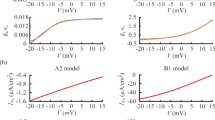Abstract
The present study introduces a new preparation of a spider vibration receptor that allows intracellular recording of responses to natural mechanical or electrical stimulation of the associated mechanoreceptor cells. The spider vibration receptor is a lyriform slit sense organ made up of 21 cuticular slits located on the distal end of the metatarsus of each walking leg. The organ is stimulated when the tarsus receives substrate vibrations, which it transmits to the organ’s cuticular structures, reducing the displacement to about one tenth due to geometrical reasons. Current clamp recording was used to record action potentials generated by electrical or mechanical stimuli. Square pulse stimulation identified two groups of sensory cells, the first being single-spike cells which generated only one or two action potentials and the second being multi-spike cells which produced bursts of action potentials. When the more natural mechanical sinusoidal stimulation was applied, differences in adaptation rate between the two cell types remained. In agreement with prior extracellular recordings, both cell types showed a decrease in the threshold tarsus deflection with increasing stimulus frequency. Off-responses to mechanical stimuli have also been seen in the metatarsal organ for the first time.






Similar content being viewed by others
References
Barth FG (1971) Der sensorische Apparat der Spaltsinnesorgane (Cupiennius salei Keys. Araneae). Z Zellforsch 112:212–246
Barth FG (1972a) Die Physiologie der Spaltsinnesorgane. I. Mo dellversuche zur Rolle des cuticularen Spaltes beim Reiztransport. J Comp Physiol 78:315–336
Barth FG (1972b) Die physiologie der Spaltsinnesorgane. II. Funktionelle Morphologie eines Mechanorezeptors. J Comp Physiol 81:159–186
Barth FG (1997) Vibratory communication in spiders: Adaptation and compromise at many levels. In: Lehrer M (ed) Orientation and communication in arthropods. Birkhäuser, pp 247–272
Barth FG (1998) The vibrational sense of spiders. In: Hoy RR, Popper AN, Fay RR (eds) Springer handbook of auditory research. Comparative hearing: insects. Springer, Berlin Heidelburg New York, pp 228–278
Barth FG (2002a) A spider´s world: senses and behavior. Springer, Berlin Heidelberg New York
Barth FG (2002b) Spider senses—technical perfection and biology. Karl von frisch-lecture. Zoology 105:271–285
Barth FG, Bohnenberger J (1978) Lyriform slit sense organ: threshold and stimulus amplitude ranges in a multi-unit mechanoreceptor. J Comp Physiol 125:37–43
Barth FG, Geethabali (1982) Spider vibration receptors. Threshold curves of individual slits in the metatarsal lyriform organ. J Comp Physiol A 148:175–185
Barth FG, Libera W (1970) Ein Atlas der Spaltsinnesorgane von Cupiennius salei keys. Chelicerata (Araneae). Z Morph Tiere 68:343–369
Baurecht D, Barth FG (1992) Vibratory communication in spiders. I. Representation of male courtship signals by female vibration receptor. J Comp Physiol A 171:231–243
Baurecht D, Barth FG (1993) Vibratory communication in spiders. II. Representation of parameters contained in synthetic male courtship signals by female vibration receptor. J Comp Physiol A 173:309–319
Blickhan R, Barth FG (1985) Strains in the exoskeleton of spiders. J Comp Physiol A 157:115–147
French AS, Torkkeli PH, Seyfarth EA (2002) From stress and strain to spikes: Mechanotransduction in spider slit sensilla. J Comp Physiol A 188:739–752
Gingl E, French AS (2003) Active signal conduction through the sensory dendrite of a spider mechanoreceptor neuron. J Neurosci 23:6096–6101
Gingl E, French AS, Panek I, Meisner S, Torkkeli PH (2004) Dendritic excitability and localization of GABA mediated inhibition in spider mechanoreceptor neurons. Eur J Neurosci 20:59–65
Höger U, Seyfarth E-A (2001) Structural correlates of mechanosensory transduction and adaptation in identified neurons of spider slit sensilla. J Comp Physiol A 187:727–736
Höger U, Torkkeli PH, Seyfarth E-A, French AS (1997) Ionic selectivity of mechanically activated channels in spider mechanoreceptor neurons. J Neurophysiol 78:2079–2085
Maier L, Root TM, Seyfarth E-A (1987) Heterogeneity of spider leg muscle: histochemistry and electrophysiology of identified fibers in the claw levator. J Comp Physiol B 157:285–294
Press WH, Flannery BP, Teukolsky SA, Vetterling WT (1990) Numerical recipes in C. Cambridge University Press, Cambridge
Sekizawa SI, French AS, Höger U, Torkkeli PH (1999) Voltage-activated potassium outward currents in two types of spider mechanoreceptor neurons. J Neurophysiol 81:2937–2944
Seyfarth E-A, French AS (1994) Intracellular characterization of identified sensory cells in a new spider mechanoreceptor preparation. J Neurophysiol 71:1422–1427
Seyfarth E-A, Pflüger HJ (1984) Proprioceptor distribution and control of a muscle reflex in the tibia of spider legs. J Neurobiol 15:365–374
Seyfarth E-A, Bohnenberger J, Thorson J (1982) Electrical and mechanical stimulation of a spider slit sensillum: outward current excites. J Comp Physiol A 147:423–432
Torkkeli PH, Sekizawa SI, French AS (2001) Inactivation of voltage–activated Na+ currents contributes to different adaptation properties of paired mechanosensory neurons. J Neurophysiol 85:1595–1602
Acknowledgment
This study was supported by grant P16348 of the Austrian Science Fund (FWF) to F. G. Barth. All experiments were carried out in accordance with current laws in Austria.
Author information
Authors and Affiliations
Corresponding author
Rights and permissions
About this article
Cite this article
Gingl, E., Burger, AM. & Barth, F.G. Intracellular recording from a spider vibration receptor. J Comp Physiol A 192, 551–558 (2006). https://doi.org/10.1007/s00359-005-0092-3
Received:
Revised:
Accepted:
Published:
Issue Date:
DOI: https://doi.org/10.1007/s00359-005-0092-3




